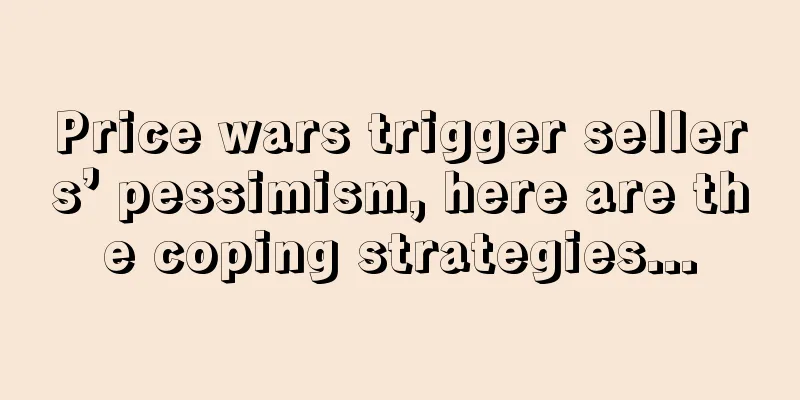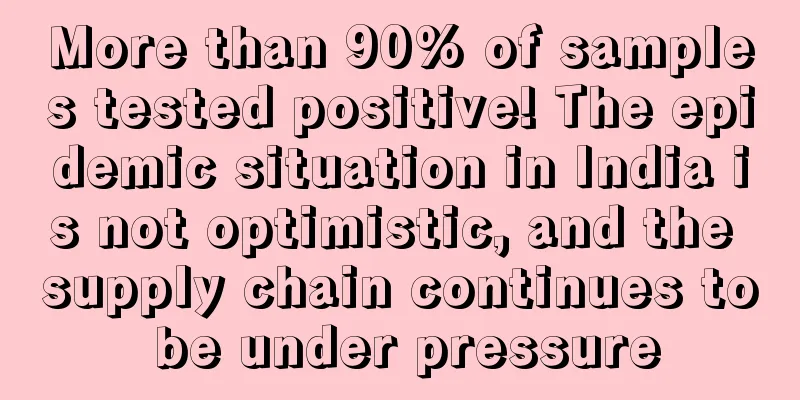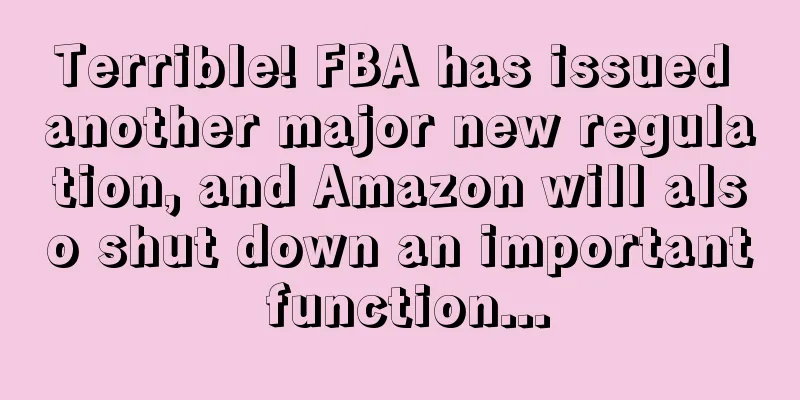Price wars trigger sellers’ pessimism, here are the coping strategies...

|
In recent times, price wars have intensified, and many sellers have turned into cross-border philanthropists. Low-price strategies such as selling for 19.9 yuan, with a cost of 50 yuan, or free shipping at 9.9 yuan are common. For example, a seller said that a large number of new sellers flooded into the toy category he was in at the end of April. Many people started with products that were originally priced at 15 euros to just break even, and some were even more "ruthless" and sold them at 9.9 euros.
The “bloody” price war continues, sellers: For the benefit of people abroad?
This price war was described by sellers as bloody and brutal. The logic of the sellers who adopted the low-price strategy is actually this: they sell at a low price in the early stage, and then raise the price after accumulating sales and rankings. However, it is easy to overlook that after a period of time, when they want to raise the price, there are still a large number of new sellers behind them who continue to adopt the low-price strategy. This spiral low-price strategy will make it impossible for the sellers in front to get up. A bunch of sellers fight each other, and the Americans are the ones who benefit in the end.
A problem that can easily arise with this way of playing is that when you sell at a loss, you will keep losing money and end up bankrupting yourself.
Some sellers also said frankly that this is just to lower the price of the category by one's own strength and benefit the people abroad. Sellers said that Amazon sellers are so squeezed that they can just lie down.
As the price war continues, a theory by an industry insider has also sparked criticism, and this theory is the spiral strategy .
The meaning of the spiral strategy is that for most sellers, they can accept making less money or even breaking even, but if they sell at a loss, many sellers are very unwilling to do so. However, the difference of the spiral strategy is that when most sellers are unwilling to lose money, you sell at a loss. The idea of this low-price strategy is to let sellers accept temporary low prices, or even losses, so as to drive sales through price and push operations into an upward spiral.
Is the spiral play really wrong?
How do sellers view this strategy? Currently, there are mainly the following groups :
1. The Opposition
Seller A: Low prices that violate the law of value are troublemakers. Seller B: I lower the price only because I have no choice. I get annoyed when I see people selling at a low price right from the start. Seller C: It's simply messing up the market.
2. Reasonable
One seller said: "Others just combine advertising costs with low prices. It is a common strategy to enter the market at a low price. Objectively speaking, supermarkets' 50% discount on all items at a new opening is also to increase exposure, click-through rate, conversion rate, and comments. The low-price circle-style operation strategy that has been a hot topic in the past two days has attracted a lot of criticism from friends in the industry.
I have a slightly different view. According to the content of the last training I attended, the new product period is to pursue a super high conversion rate and quickly gain weight. Although I strongly disagree and am unwilling to lower prices, in the case of serious product homogeneity, most people can only rely on low prices to increase conversion rates, and the effect is also there.
All I can say is that existence is reasonable. There is no need for moral condemnation. I am not trying to take sides, I just want to encourage people to think more about the reasons for this practice. ”
Some sellers said that this strategy is reasonable, but they were led in the wrong direction. Some sellers said: Recently, many people have been discussing the spiral method. In fact, American talents are the originators of price wars. Sellers with some ideas, when they first put their products on the shelves, only think about placing orders to prove their methodology. Whether they can make money is secondary. This is a very normal behavior. Don't be led by some sellers and institutions. I think it is just a normal business behavior and there is nothing shameful about it.
Some sellers also said: As for the spiral strategy, it is really a normal operation strategy. In the early stage, low prices are used to attract traffic, make reviews, and increase sales. In the middle and late stages, prices are raised to make profits. If sales are not good, prices are lowered to stimulate sales. As long as it is not a blue ocean product, who has not played this way? You can't blame others just because they have summarized a name. Such great malice is not something that a single individual should bear.
The seller also added: From an economic perspective, price cuts are a spontaneous market behavior, and bad money driving out good money is inevitable. The biggest problem is the increase in Amazon's warehousing costs, the influx of inexperienced newcomers, the blind deception of unscrupulous training institutions, and the single-minded operation of many people. The competition in the overall environment will only become more and more fierce. The comfortable days of entering the automatic cruise mode by adjusting prices are long gone. Price war triggers sellers' pessimism, peers offer advice on how to deal with it
Now, as fierce price wars have broken out on the Amazon platform, many sellers have not only seen a serious decline in their orders, but have also fallen into the dilemma of selling at a loss by selling at a low price. The emotions of sellers have exploded all of a sudden, and pessimism has spread among the seller community.
One seller said helplessly : "Today, all cross-border groups are exuding a bit of pessimism. I was in a good mood recently, but I suddenly feel a little anxious."
Another seller also sighed : "Amazon has become like Yaduoduo, and I can't hold back my emotions."
In fact, no matter what platform or category, as long as there is competition, there will be price wars. It’s just that this year, due to the influx of a large number of new sellers into Amazon, the price war here is particularly fierce.
Facing this year's price war, the editor believes that the most important thing for sellers to do is to calm down, and then after venting their emotions, they should prepare countermeasures. Instead of being kidnapped by anxiety, they should not blindly get stuck in the price war, or even give up product quality and sell inferior products as good ones because of the price war.
Regarding the "price war", the following handling method shared by a seller a few days ago received a lot of likes.
1. If it is the same product, calculate the cost first. If the competitor's price is lower than the cost price, consider several factors : First, whether the supplier's shipping price is too high, resulting in the competitor's profit margin to reduce the price. Second, whether the competitor is a new entrant into the market, and formulate a strategy based on his logic and strategy of price reduction.
Second, when this product is mature and stable, and there is sufficient profit margin, you can adjust it down appropriately. Because the product has been around for a long time, there are more competitors, and it is normal for profits to decline, but there is no need to lower the price than the competitors. Low price is not the only factor that affects orders.
3. Many competitors like to start a price war by changing materials or processes. If it will affect product quality, we will not follow up. Time will tell you the answer.
4. Sometimes, in response to price wars with competitors, we will develop some special products to deal with them. Of course, the premise is that we don’t lose money, but we can drag their links.
5. Do something about the brand. The most basic thing is to customize the appearance, including color, size, logo printing , and customized outer box packaging.
Finally, I want to say that sellers should not blindly get caught up in price wars, because when you think you can beat all other competitors with 9.99, you will suddenly find that sellers selling at 7.99 come out, and even 6.99 or 4.99 are waiting behind. The most important thing is to keep a calm mind and prepare a series of coping strategies.
Amazon Platform |
>>: Go for the final payment! Tmall 618 shopping starts tonight
Recommend
Zebao’s parent company was sued for more than 50 million by its suppliers!
When many cross-border sellers experienced bankru...
For off-site promotion in 2023, how do sellers choose the delivery platform?
At the beginning of the new year, as the e-commer...
What is Brava Home? Brava Home Review, Features
Brava Home is a technology company that believes w...
Collectibles become a new cross-border business opportunity. eBay releases popular categories to help collectibles go global
Today, eBay , one of the world's top collecti...
What is FalconX? FalconX Review, Features
FalconX is a digital asset and cryptocurrency fin...
What is CBO? CBO Review, Features
CBO (Campaign Budget Optimization) is a marketing...
Lazada cooperates with police to seize more than 82,000 fake batteries
On May 18 this year , based on the clues from the...
What is Steve Madden? Steve Madden Review, Features
<span data-docs-delta="[[20,{"gallery"...
Online business grows rapidly, Costco's quarterly sales reach nearly $43.9 billion
Recently, Costco , the largest chain membership w...
Anker's "Waterloo" track, a place where talents emerge in large numbers
" Everyone is discussing going overseas and ...
What is Wirecard? Wirecard Review, Features
Wirecard AG is a German global financial services...
What is Scan&Go Ignica? Scan&Go Ignica Review, Features
Scan&Go Ignica is a shopping app. Function 1. ...
What is Dongyi Cross-border ERP? Dongyi Cross-border ERP Review, Features
Dongyi Cross-border ERP is committed to solving sa...
What is ETD? ETD Review, Features
ETD is the acronym for Estimated Time of Departur...
The second-hand fashion market is expected to grow by 185% in the next ten years
Under the influence of the epidemic and the short...









